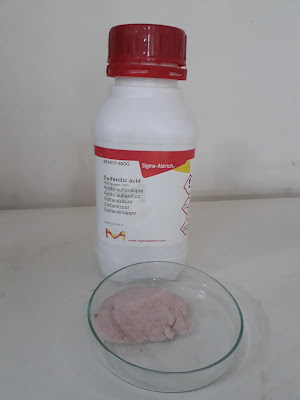CHEMICAL PRODUCT IDENTIFICATION
The organic chemical sulfanilic acid, also known as 4-amino benzene sulfonic acid, is used in the manufacture of dyes, & medicines, & as a reagent in analytical chemistry.
- Product Name: Sulfanilic acid.
- Stay Safe – Sulfanilic Acid SDS!
COMPOSITION, INFORMATION ON INGREDIENTS
- Chemical Family: Organic acid.
- CAS Number: 121-57-3.
- Formula: C6H7NO3S OR NH2C6H4SO3H.
- Component Name: Sulfanilic acid.
- Synonyms: p-Aminobenzene sulfonic acid; 4-Aminobenzenesulfonic acid; Aniline-4-sulfonic acid.
- Formula Wt.: 173.19.
HAZARDS IDENTIFICATION
- Signal Word: Warning.
- May cause serious eye damage & skin irritation, & corrosion.
- Might cause allergies to the skin.
- May cause respiratory irritation.
- Ingestion might cause gastrointestinal discomfort.
- Dust may cause respiratory irritation.
- May cause allergic reactions.
- Avoid dust.
FIRST-AID MEASURES
- Seek medical guidance or treatment.
- If Inhaled: If you feel unwell, contact a doctor.
- If in the Eyes: Rinse carefully for a few minutes with water. If contact lenses are present & simple to remove, do so. Continue to rinse.
- If eye irritation continues: Seek medical guidance or treatment.
- If on the Skin: Use lots of water to wash.
- When skin inflammation happens: Seek medical guidance or treatment.
- Before reusing: Wash any compromised clothing.
- If Swallowed: Mouth with water. If you are not feeling well, contact a doctor.
FIRE-FIGHTING MEASURES
- Keep away from heat, sparks, & open flames.
- Use water, foam, or CO2 to extinguish.
- flammable(combustible) solid.
ACCIDENTAL RELEASE MEASURES
- Clean up the spill, put it in a container or bag that is sealed, & then throw it away.
- Wash spill site after material pickup is complete.
HANDLING & STORAGE
- Store peracids, anhydrides, & acids together.
- Store in a cool dry place.
- Keep the container tightly closed.
EXPOSURE CONTROLS, PERSONAL PROTECTION
- Avoid contact of this with skin & eyes.
- Use this with adequate ventilation.
- Must wear appropriate personal protective equipment, like gloves & safety goggles.
- Keep this away from heat, sparks, & open flames.
- After handling, carefully wash your hands.
- Work clothes that have been contaminated shouldn’t be taken outside of the place.
PHYSICAL & CHEMICAL PROPERTIES
- Appearance: Flat, greyish-white crystals. Odorless.
- Melting Point: 280-300 °C. (without melting, decomposes).
- Solubility: soluble in the water slowly. Cold organic solvents are nearly insoluble.
STABILITY & REACTIVITY
- Avoid coming into contact with strong bases, strong acids, & strong oxidizers.
- Shelf Life: If properly preserved then the shelf life is indefinite.
TOXICOLOGICAL INFORMATION
- Acute Effects: serious skin irritation, allergy, & eye discomfort.
- Chronic effects: N.A.
- Target organs: N.A.
- ORL-RAT LD50: 12300 mg/kg
- IHL-RAT LC50: N.A.
- SKN-RBT LD50: N.A.
ECOLOGICAL INFORMATION
- Sulfanilic acid poses an environmental risk when introduced into the environment since it is poisonous to aquatic life. Since it could potentially harm fragile ecosystems, its production and usage must be closely supervised & regulated.
DISPOSAL CONSIDERATIONS
- Dispose of in accordance with local, state, & federal regulations.
TRANSPORT INFORMATION
- Name of Shipment: Not regulated. Hazard class: N/A. UN number: N/A.
REGULATORY INFORMATION
- TSCA & EINECS listings (204-482-5).
OTHER INFORMATION
This Sulfanilic Acid SDS is intended as a piece of advice & is based on data & tests that are likely to be reliable. I don’t guarantee the data’s correctness or completeness & I’m not responsible for any resulting losses. The information is only being provided for your review, research, & verification. I DO NOT ASSUME RESPONSIBILITY AND EXPRESSLY DISCLAIM LIABILITY FOR LOSS, DAMAGE, OR EXPENSE RESULTING FROM OR IN ANY WAY CONNECTED WITH THE HANDLING, STORAGE, USE, OR DISPOSAL OF THIS PRODUCT FOR THE FOREGOING AND OTHER REASONS.

CONCLUSION
Sulfanilic acid is an organic molecule used as a reagent in analytical chemistry, as well as in the manufacture of colours & medicines. When carrying out necessary laboratory precautions & protocols, such as donning the proper personal protective equipment, labelling the substance properly, & disposing of it properly, it is typically safe to handle. When handling any laboratory reagent, including sulfanilic acid, it is crucial to constantly adhere to good laboratory practices & standard operating procedures as well as to utilize the appropriate personal protective equipment. Please seek emergency medical assistance if any unfavourable reaction takes place. It is neither combustible nor explosive, & you can put out a fire with water, foam, or CO2. People should also be mindful of any potential allergies in the material & treat it appropriately. Some people could be an allergic reaction to sulfanilic acid, so it should be handled with caution. One must follow this Sulfanilic Acid SDS while handling this product.
